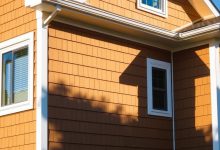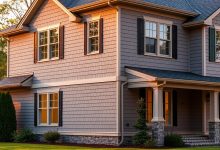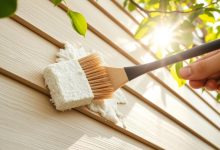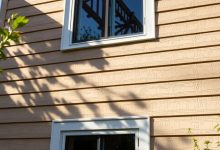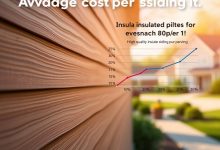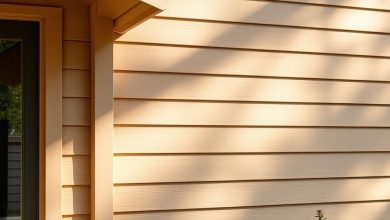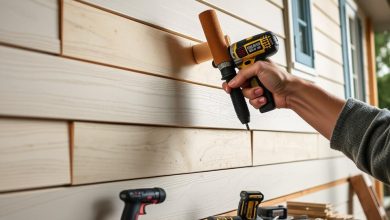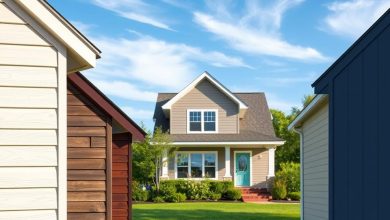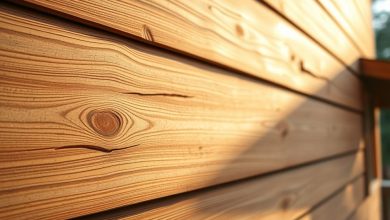Insulated Siding: Enhance Your Home’s Efficiency
As a homeowner, you’re always looking to make your home more energy efficient. Installing insulated siding is a smart choice. It not only makes your home look better but also keeps it warm in winter and cool in summer.
Choosing insulated siding means a cozier home and a smart investment. It’s made to last, giving you peace of mind and a comfortable living space.
Key Takeaways
- Insulated siding improves energy efficiency
- Enhances the exterior of your home
- Reduces heat loss and energy consumption
- Provides a comfortable living space
- Contributes to overall home improvement
What Is Insulated Siding and How Does It Work
Insulated siding is a new way to cover your home’s exterior. It makes your home more energy-efficient. It works by keeping the inside warm in winter and cool in summer.
Homeowners like it because it saves money on energy bills. It also makes their homes more comfortable. Knowing how it works helps you choose the right siding for your home.
The Structure of Insulated Siding
Insulated siding has several layers. The outside layer is made from materials like vinyl or wood. It looks good and lasts long. Inside, there’s a foam insulation layer that saves energy.
The Science Behind Its Efficiency
Insulated siding stops heat from moving in and out. The foam insulation layer does this. It keeps your home warm in winter and cool in summer.
As Energy Star says, good insulation can cut energy bills by up to 30%. This makes your home more energy-efficient.
The Benefits of Insulated Siding
Insulated siding combines insulation with exterior finishing, bringing many benefits to homeowners. It boosts a home’s energy efficiency, helping to lower energy bills. This makes it a smart choice for those wanting to save money.
Energy Efficiency Improvements
Insulated siding adds an extra layer of insulation to homes. It keeps homes warmer in winter and cooler in summer. This means lower energy use and smaller utility bills.
The U.S. Department of Energy says homeowners can save 10% to 30% on energy bills. This is by improving their home’s insulation.
Noise Reduction Properties
Insulated siding also reduces noise. The extra insulation blocks out external sounds, making homes quieter. This is great for homes near busy roads or in noisy areas.
Enhanced Structural Integrity
Insulated siding also boosts a home’s structural integrity. It adds a layer of protection against wind, rain, and extreme temperatures. This reduces damage risk.
“Insulated siding not only improves energy efficiency but also enhances the durability of a home’s exterior.”
This can extend the siding’s life and cut down on maintenance costs over time.
Types of Insulated Siding Available in the US Market
The US market has many insulated siding options. These options meet different homeowner needs and tastes. Each material and style has its own benefits, like energy efficiency, durability, and looks.
Vinyl Insulated Siding Options
Vinyl insulated siding is a favorite for many homeowners. It’s energy efficient and easy to care for. You can find it in many styles and colors, fitting various home designs.
Fiber Cement Insulated Alternatives
Fiber cement insulated siding is a good choice too. It combines insulation with toughness. Made from cement, sand, and cellulose fibers, it’s strong and lasts a long time.
This siding also keeps pests and fire away, making it safe for homes.
Wood-Look Insulated Products
If you want a traditional or rustic look, wood-look insulated siding is for you. It looks like real wood but has modern insulation. It gives your home a warm and inviting feel while saving energy.
When picking insulated siding, think about your climate, budget, and what you like. This helps choose the best siding for your home.
Understanding R-Values and Insulation Materials
Improving your home’s energy efficiency starts with knowing about R-values and insulation. Insulated siding acts as a shield against outside temperatures. Its success depends on its R-value and the insulation type.
What R-Values Mean for Your Home
The R-value shows how well insulation stops heat flow. A higher R-value means better insulation. In cold areas, a high R-value keeps warmth in. In warm areas, it keeps heat out.
Choosing the right R-value depends on your local weather, siding type, and energy goals.
Popular Insulation Materials and Their Properties
Foam board and fiberglass are common in siding insulation. Foam board has high R-values per inch, making it a top pick. Fiberglass is cheaper and works well, but not as high.
The insulation you pick impacts your siding’s R-value, durability, and upkeep.
Knowing about insulation materials and their R-values helps you choose wisely. The right mix can boost your home’s energy use and comfort.
Cost Analysis: Investment vs. Returns
Understanding the cost of insulated siding is key to deciding if it’s right for your home. You need to look at both the initial cost and the long-term savings.
Initial Installation Costs
Installing insulated siding can cost more than traditional siding. The price depends on the material, your home’s size, and local labor costs. On average, it can cost between $10 to $15 per square foot. For a typical home, this means spending $8,000 to $20,000 or more.
Material choices greatly affect the initial cost. Vinyl is often cheaper than fiber cement or wood-look options. But, remember to think about the long-term benefits when comparing prices.
Long-Term Energy Savings Calculation
Insulated siding helps save energy. It keeps your home’s temperature steady, reducing the need for heating and cooling. Homeowners can save 10% to 30% on energy bills. This depends on your location, the insulation’s quality, and your home’s current energy efficiency.
Tax Incentives and Rebates for Energy Efficiency
Installing insulated siding can also get you tax breaks and rebates. Governments offer these to encourage energy-saving home upgrades. These can help lower the initial cost, making insulated siding more appealing financially.
Looking into available incentives can greatly lower the cost of insulated siding. With these savings and long-term energy benefits, insulated siding is a wise choice for many homeowners.
Installation Process and Requirements
Knowing what you need for installation is key to getting the most out of insulated siding. A detailed approach helps the siding work well and last as long as it should.
Pre-Installation Home Assessment
A pre-installation check is vital before putting in insulated siding. It involves looking at the exterior walls for damage or wear. It also checks if repairs or special steps are needed. A pro can spot issues that might mess up the install.
Professional Installation Steps
Installing insulated siding professionally takes a few steps. First, the old siding is taken off, and the area is checked and fixed if needed. Next, a weather-resistant barrier is put in, followed by the insulated siding.
The siding is then aligned and fixed to fit tightly and keep out gaps. Lastly, the job is checked to make sure it meets quality and manufacturer standards.
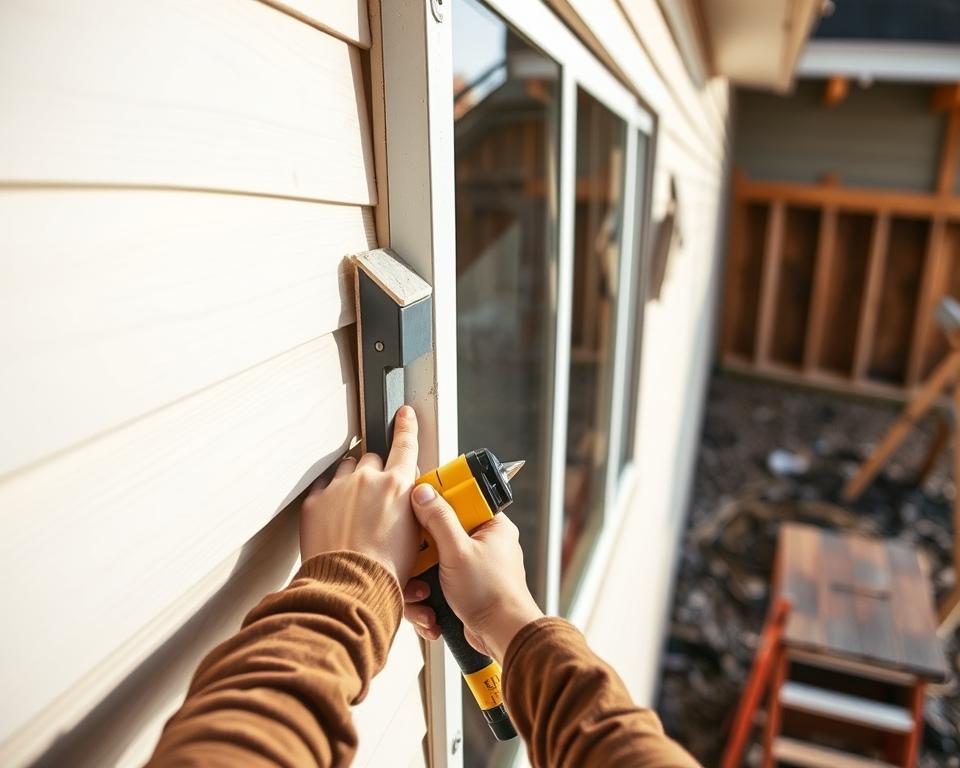
DIY Possibilities and Limitations
Some homeowners might try installing insulated siding themselves. But, it’s not for everyone. It needs the right tools and a good grasp of the process. Homeowners should think about their skills and the job’s complexity before starting.
Some makers might have special rules or advice for DIY jobs.
Common Installation Pitfalls to Avoid
Some common mistakes in installing insulated siding include bad alignment, not sealing enough, and not following the maker’s instructions. It’s important to avoid these to make sure the siding works right and lasts long.
Whether you’re hiring a pro or doing it yourself, knowing these issues can help. It ensures the siding does its job well and lasts as long as it should.
Enhancing Curb Appeal and Home Value
Insulated siding offers many design options and colors. It can greatly improve a home’s look and possibly increase its value. This boost is not just about looks. It also shows the quality and modernness of the materials.
Improving curb appeal is key for a good first impression. This is true whether you’re selling your home or just want to enjoy its look. Insulated siding comes in various styles to match different home designs, from modern to traditional.
Design Options and Color Varieties
Insulated siding has many designs and colors. Homeowners can pick the perfect match for their home’s style. Whether you like a classic or a modern look, there’s an insulated siding option for you.
Impact on Property Resale Value
Insulated siding can significantly impact a home’s resale value. Buyers often pay more for homes that are well-kept and energy-efficient. Insulated siding improves your home’s look and energy use, making it a smart investment.
Choosing the right design and color can increase your home’s value. It also brings the benefits of better energy efficiency.
Maintenance Requirements and Durability
Keeping your insulated siding in good shape is important. It helps it last longer and work better. It also keeps it looking good and saving energy.
Seasonal Maintenance Guidelines
It’s vital to take care of your insulated siding. Seasonal inspections help spot problems early. In spring, check for winter damage.
Summer is the best time to clean it. This removes dirt and keeps it looking nice. In fall, make sure it’s ready for winter by checking for gaps or cracks.
Don’t forget to clean your gutters regularly. This stops water damage that can harm the siding. Keep your siding free of leaves and branches to keep it looking and working well.
| Season | Maintenance Task | Benefits |
|---|---|---|
| Spring | Inspect for winter damage | Early detection of issues |
| Summer | Clean siding | Maintains appearance and functionality |
| Fall | Check for gaps or cracks | Prepares siding for winter |
Expected Lifespan and Warranty Information
The expected lifespan of insulated siding depends on the material and how well it’s installed. It usually lasts 20 to 40 years. Most makers offer a warranty for material and labor issues.
It’s key to understand the warranty. This tells you what’s covered and for how long.
Insulated vs. Traditional Siding: A Comparative Look
Choosing the right siding for your home is a big decision. You need to think about how well it performs in bad weather, its cost, and how it looks. These factors help you decide what’s best for your home.
Performance in Extreme Weather Conditions
Insulated siding does better in bad weather than traditional siding. It keeps your home’s temperature steady, which means your heating and cooling systems work less hard. Traditional siding doesn’t insulate as well, so it’s not as good in extreme weather.
In harsh winters, insulated siding keeps the cold out. In hot summers, it keeps the heat out too. This makes your home more comfortable and can save you money on energy bills.
Cost-Benefit Analysis Over Time
Insulated siding costs more upfront than traditional siding. But, it saves you money in the long run. The energy savings from insulated siding can pay for itself over time, making it a smart investment.
| Siding Type | Initial Cost | Long-Term Savings |
|---|---|---|
| Insulated Siding | $10,000 | $3,000 (over 10 years) |
| Traditional Siding | $8,000 | $0 (no significant savings) |
Aesthetic and Functional Differences
Both types of siding come in many styles and colors. This means you can find one that fits your taste. Insulated siding often looks modern, while traditional siding has a classic feel. Insulated siding also saves energy and reduces outside noise better than traditional siding.

Regional Considerations for American Homeowners
Regional climate variations are key in choosing the right insulated siding for homes across America. Different areas face unique challenges, from cold winters to hot summers. This means they need specific siding solutions.
Best Options for Northern States
In northern states, durable and energy-efficient siding is a must. Insulated siding that can handle harsh winters and keep homes warm is best. Products with higher R-values are great here, as they keep cold out better.
Ideal Solutions for Southern Climates
In southern climates, heat-resistant and moisture-protective siding is a must. Homeowners need siding that reflects sun and protects against moisture. Vinyl and fiber cement siding products are good choices, as they are durable and look great.
Conclusion: Making the Smart Investment in Your Home’s Efficiency
Insulated siding does more than just keep your home warm. It also makes your home look better and increases its value. Knowing about the different types and how they work helps homeowners make smart choices.
Choosing insulated siding can save you money on energy bills over time. It also helps the environment. There are many options, like vinyl, fiber cement, and wood-look, to fit any budget.
Insulated siding does more than just save energy. It also makes your home last longer and look better. It’s a great choice for anyone looking to improve their home, whether they plan to stay or sell.

